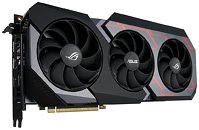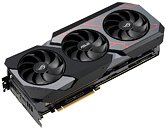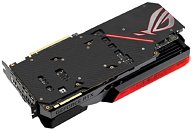Monday, January 7th 2019

ASUS to Introduce the ROG MATRIX GeForce RTX 2080 Ti Graphics Card With Integrated AIO "Infinity Loop"
ASUS is looking to one-up the competition in the flagship graphics card market with its ROG MATRIX rendition of the RTX 2080 Ti interpretatioin of NVIDIA's silicon. The ROG MATRIX GeForce RTX 2080 Ti will incorporate an AIO watercooling solution complete with waterblock, pump, radiator and fans in a triple-slot design. ASUS claims the Infinity Loop cooler will bring about performance equivalent of that of an external 240mm AIO - a bold claim, since physics and proximity of the radiator and fans themselves to the PCB and die should dictate a higher temperature than an otherwise completely external solution.
That said, the design of the Infinity Loop is likely one of the most interesting graphics card cooling designs in some time, with a completely self-contained solution. The shroud and side of the graphics card feature laser cutouts and LED-illuminated elements (because 2019 wouldn't be much different from 2018 in that regard). Out-of-the-box clocks are set at 1815 MHz before any additional overclocking, and the card takes power from 2x 8-pin power connectors. The cost? North of $1600. Now that's design, even in the price-tag.
Source:
ASUS
That said, the design of the Infinity Loop is likely one of the most interesting graphics card cooling designs in some time, with a completely self-contained solution. The shroud and side of the graphics card feature laser cutouts and LED-illuminated elements (because 2019 wouldn't be much different from 2018 in that regard). Out-of-the-box clocks are set at 1815 MHz before any additional overclocking, and the card takes power from 2x 8-pin power connectors. The cost? North of $1600. Now that's design, even in the price-tag.



28 Comments on ASUS to Introduce the ROG MATRIX GeForce RTX 2080 Ti Graphics Card With Integrated AIO "Infinity Loop"
I know, I'm a simple guy, but...
If you're selling it - it's BRILLIANT! :roll:
Also, an overloaded rad pumps out a TON of heat, esp if the pump is at a low speed - I've learned this by using the NZXT Kracken with a Corsair h55 on a 1080ti, and even with a 1600rpm fan the bottom of the rad was steaming hot, literally felt like the tubes were about to melt after an hour of gaming, and the air coming out of the rad could have slow roasted a ham.
I moved back to the heatpipe cooler since there was no way that h55 could take that kind of punishment regularly, so im curious to see how this does since it doesn't have a ton more surface area than a 120mm rad.
i guarantie that that asus loop gpu offer much much more brain that amd vega 64,even vega is half cheaper.
amdvega still eat more juice but its also almost 50% slower.
buy that asus 2080 ti loop gpu and buy amdvega64,keep it 2 years, then try sell both. forget amdvega64. no1 buy it, but that asus goes at once and i promise, and good price.
Oops nearly missed adding the quote tho i suspect most of us know i meantPlease forgive his incoherent command of the English/American language
itsprobably not a native speakerIt’s about already mentioned before, inferior to fullcover cooler design, inherent to almost any AIO on the market. Cheap, FE compatible 2080Ti and watercool/aquacomp/EK fullcover will be always preffered by Me, myself and I (and have no doubt any custom loop user). Any other instance - some strix or !amp will do fine. And it will cost roughly 1100-1300$. Not even talking that FE+HQ fullcover is far more superior solution than these.......AIO’s.
VRM, PCB design won’t play better here - since pascal, You have gpu limit, voltage, current, temp, TDP...... every corner limited.
LN2, you might say? Well, one problem here aswell - it’s all tied up with sponsors and sponsorship, no sales for that part of market.
So, all in all - I have only one thing that comes to my mind - and it makes me curious “When PC market ended up being ‘savvy customers society , and became market of consuming society, with ridiculous overprice, lack of new ideas, and lazy ignorant developers, that want to eat much without working much?”
P.S. I am awared of ASUS policy, so I really,reaaally doubt they will unlock tdp limit like somekingpin/lightning does have.